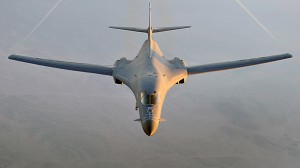Defense Careers Background
 From simple rocks to sophisticated satellite surveillance systems, people have always sought ways to defend themselves and to protect their territory and to promote their interests. The development of weapons, tools, vehicles, and strategies, both defensive and offensive, plays a crucial role in the safety and welfare, as well as the economic health, of almost every society. Today, defense is a multibillion-dollar enterprise with private industries building weapons and defense systems for the government.
From simple rocks to sophisticated satellite surveillance systems, people have always sought ways to defend themselves and to protect their territory and to promote their interests. The development of weapons, tools, vehicles, and strategies, both defensive and offensive, plays a crucial role in the safety and welfare, as well as the economic health, of almost every society. Today, defense is a multibillion-dollar enterprise with private industries building weapons and defense systems for the government.
The rudimentary weapons of earlier times—rocks, slings, and spears—were made of whatever materials were available. The weapons were often made by the warriors who used them. At the same time people developed weapons, they also developed ways to protect themselves. The earliest armor was of animal hides, and as weapons evolved into spears and arrows, warriors learned to fashion metal into shields.
Another early weapon was fire. The Greeks used incendiary weapons as early as the fourth century BC. Gunpowder, invented by the Chinese, became one of the most important developments in the art of war. By the 14th century, armies had adapted gunpowder for use with cannons, which could fire large stones or metal balls for long distances and destroy a city’s fortifications. Mortars, developed by the Dutch in the 17th century, and other explosive bombs were used to terrible effect. The castles and other fortifications that had protected cities for so many centuries were rendered far less effective by these new weapons. Gunpowder was also adapted for use in firearms by the 14th century and in rockets by the 13th century. Cannons were also mounted on sea vessels. In the 16th century, the British designed the first real warship, and the British naval fleet soon dominated the seas.
The invention of the airplane and the automobile married private industry to war and defense efforts in the early part of the 20th century. The first military order for an airplane was made soon after Orville Wright and Wilbur Wright’s first flight in 1903. By 1911, airplanes were being used in war. At first, airplanes were used mainly for reconnaissance missions. However, they soon were adapted for dropping bombs. In peacetime, the government relied on industry to produce equipment such as vehicles, tanks, naval vessels, and airplanes. World War I and, to a greater extent, World War II proved just how adaptable private industry was to producing the materials of war. When the United States entered World War II, industries that previously had little to do with defense efforts were mobilized to produce everything needed for the war, from supplies to vehicles to weapons.
Other industries were tapped for valuable defense technologies. Radar, radio, and sonar were useful not only for guiding aircraft and naval vessels but also for warning of impending attacks. Chemical weapons, such as the mustard gas used in World War I, made new types of defense equipment, such as gas masks, vital to the soldiers on the ground. Automobiles made armies even more flexible; where previously they had relied on the railroads or horse-drawn wagons for supplies, armies could now be deployed and maintained virtually anywhere. The automobile was also adapted for strategic use in battle. Outfitted with armor and heavy weapons, a tank became a ferocious, seemingly unstoppable weapon.
Another important innovation of World War II was the development of the first jet engine. By the end of the 1950s, jet travel had revolutionized the airline industry, opening air travel to millions of people around the world. The Cold War between the United States and the Soviet Union, coupled with the space race that developed between the two countries, saw the dedication of enormous amounts of resources to the development of ever more sophisticated weapons. Cold War-era weapon development included conventional, nuclear, biological, and chemical weapons; air and naval craft; and surveillance, intelligence, communications, and computer technology. Much of the technology developed initially for defense has been adapted for commercial and civil use. The aerospace industry, for example, provides not only military aircraft but aircraft for commercial aviation.
Defense and the aerospace industry remain intrinsically linked. The use of aircraft and space technology has become a dominant force in modern warfare. The Persian Gulf War (1990–91) showed the strategic importance of these technologies. Using aircraft, long-range missiles, and sophisticated guidance systems coupled with satellite-based intelligence operations, the United States and its allies were able to weaken the Iraqi army almost to the point of surrender before the land-based war even began.
After tensions eased between the United States and Russia, new concerns arose with smaller countries, such as North Korea, that had the technology to build rockets that could reach the United States. The Strategic Defense Initiative, proposed by Ronald Reagan and known as Star Wars, died with the end of the Cold War in the 1980s, but new concerns prompted the government to invest in a new national missile defense system.
Today, the United States is currently occupying Afghanistan and Iraq, and concerned with fighting the threats of terrorism that come from terrorist groups from various parts of the world. Billions of dollars are being spent on developing high-tech weapons, aircraft, communications systems, and other methods of protecting the United States from traditional military attacks as well as chemical and biological warfare.